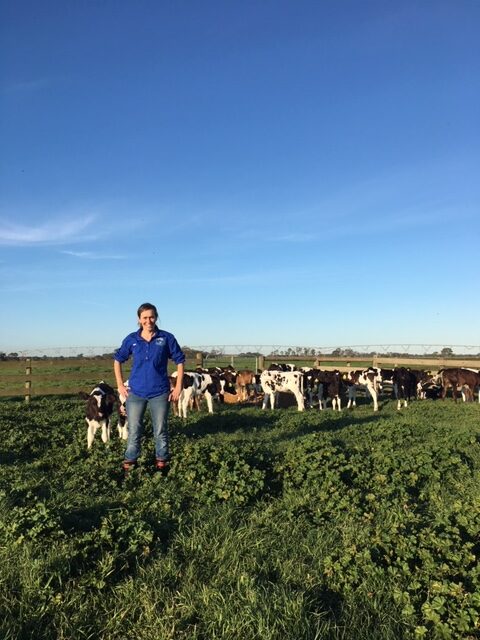Milking the Solar System
Case Study
2019 Lion Dairy Pride Landcare Grant
| Grant Recipient: | Bree Whittaker |
| Farm/Dairy Name: | Whittaker Farms |
| State/Town: | VIC/Denison |
| Project Name: | Milking the Solar System |
| Grant Amount: | $10,000 |
Background
The Whittaker family own and operate four dairies in in the Macalister Irrigation District, Gippsland, Victoria. They manage four herds of predominately Fresian cattle. To produce enough feed to meet the needs of their high producing cows, they irrigate their pastures and fodder crops using a combination of centre pivots, high flow flood and lateral sprays.
The Whittaker family maintain a milking herd of 1,000 milkers, on the main farm, who collectively produce 5 million litres of milk each year. The dairy shed is a modern 70 unit dairy with a computerised rotary set-up that allows them to efficiently milk the herd and ensure premium quality milk with the assistance of cell sense meters.
However, this technology comes at a price as rising costs of electricity were significantly eating into the profitability and sustainability of the operation. Not wanting to compromise the dairy set-up the Whittaker family looked for alternative renewable sources of energy.
The family was also concerned about the environmental impact of relying on electricity generated by fossil fuels and so were even more keen to add renewable energy into the mix.
After being made aware of the Lion Dairy Pride Landcare Grants, Bree Whittaker said the family decided to apply to partially fund the cost of solar panels.
Project Overview, Purpose and Goals
Setting an ambitious goal Bree estimated once they panels were installed they’d cover 0.05 hectares of roof space on the main dairy shed and produce 100 kWh.
This would reduce the family’s reliance on their energy provider and cut their electricity bills to help ensure the dairy operated into the future.
Bree said aside from the cost benefits for the operation the family also wanted to do their part to reduce their carbon footprint.
“It’s vital that we are proactive in minimising our reliance on brown coal energy and to reduce our greenhouse gas emissions. As dairy farmers we are keen to pursue a sustainable approach to dairying, to benefit our productivity and profitability,” Bree said.
The energy generated would supplement the power required to run the dairy shed’s milk cooling and water heating systems as well as its automation.
To complement the solar panels the Whittaker family invested in energy saving technology in the dairy to reduce their overall consumption.
“We are keen to see if we can use some of the ‘energy’ that is sold back into the grid to run our centre pivots and irrigation pumps,” Bree said.
Project Outcomes
Bree said the solar panels were installed in April 2019 and have since produced enough power to lower electricity bills with excess sold back into the grid.
“Dairy farms cannot rely solely on solar power to operate until battery technology improves as our morning milking occurs pre-dawn.”
“The installation was a relatively simple process to have this up and running and helping to support our dairy’s energy consumption,” Bree said.
Bree added they’ve been collecting data on the solar panels and their electricity costs to compare with the previous year.
“We haven’t had a full 12 months of data to examine yet. We are truly interested in seeing the solar system’s capacity over the summer months,” Bree said.
Bree added she is confident the installation of the solar panels has ensured the productivity and sustainability of their 1,000 head dairy herd. It has also helped them manage electricity costs in an ever-changing market.
Conclusion
Reflecting on the experience, Bree said the family had planned out the installation of the solar panels but were frustrated by the paperwork required by their energy provider.
“Hooking up the 100-kWh solar system into the grid was not simple, despite being given prior approval of the system by SPAusnet before installation.”
“When the energy retailer provide paperwork to be signed it was very challenging because they required it to be signed, initialled, witnessed, not always a simple thing to do on a family owned and operated dairy farm, and had turnaround times that were extremely hard to achieve,” Bree said.
Going forward, however, Bree said they were monitoring the panels to ensure they were maintained to continue maximum production of power.
“The recent strong winds and dry conditions have made our solar panels extremely dirty. We are working out the safest and best option to clean the panels to maximise summer solar generation,” Bree said.
Bree added that two of the other three dairies also have solar systems on the dairy roof.
“These are smaller 50kWh systems for our 50-unit rotary’s milking 400-500 cows,” Bree said.





